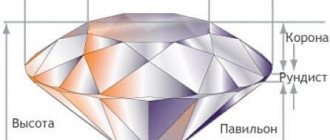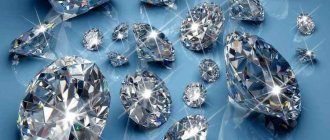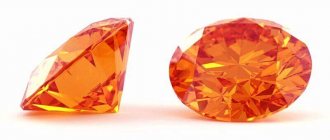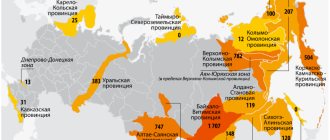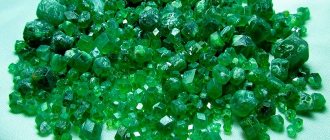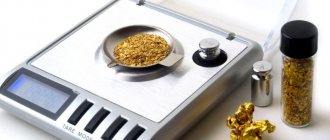Precious stones are rare minerals that have natural beauty, which in most cases manifests itself after jewelry processing. In addition to their amazing external shapes and colors, these minerals have exceptional durability and incredible strength. That is why they have a very high price, are placed in closed storage facilities and well-protected collections. And they are used as financial assets in banking.
- Cut
All forms and methods of legal regulation in this area are carried out on the basis of Federal Law No. 41-FZ of March 26, 1998 “On Precious Metals and Precious Stones”.
Main characteristics
Rarity
A quality that determines the frequency of occurrence of a mineral in nature. Precious stones possess it to the fullest. Some of them are so unique that they are found in one or several copies. However, this characteristic can easily change in one direction or another due to the discovery of new deposits, or vice versa - cessation of production due to depletion of deposits.
In this regard, carmeltazite is of particular interest - a stone that arrived on Earth from outer space. Also quite curious in this regard is the future development of mineral resources of nearby planets and asteroids, which may entail a change in the level of rarity of terrestrial gems.
Durability
It is this property of precious stones that allows them to remain unchanged for centuries. Durability is based on mechanical strength, determined by hardness, fragility, and resistance to mechanical, temperature and chemical influences.
beauty
The beauty of precious stones makes an indelible impression on any person. Thanks to it, value is formed, the desire to possess unique value is manifested and decorate it with skillful framing, creating unsurpassed jewelry. The concepts of beauty of precious stones include:
- color and reflective qualities,
- ability to take an elegant geometric shape,
- the ability to have a highly polished surface.
Emerald
Beryllium aluminosilicate crystal. The content of iron and vanadium in the crystal determines the shade of the stone, from light green to dark green. The magnificent and highly prized Colombian emeralds contain 0.05% vanadium, 0.12% iron and 0.14% chromium.
Hydrothermal emeralds Photo: Newermore ares, ru.wikipedia.org
In 1911, the German company IG Farbenindustry began producing artificial emeralds called “igmerald”. Crystals grown using the method they discovered crystallize very slowly: it took up to a year to obtain good emeralds.
In the 1930s, two companies launched the production of artificial emeralds - Carroll F. Chatham in the USA and Pierre Gilson in France. They did not patent their methods for producing emeralds; they are kept secret. It is assumed that emeralds crystallize from a solution of aluminum oxide and beryllium in a lithium molybdate melt. Good jewelry crystals using this technology are very rarely obtained and they cost only a little less than real emeralds.
Mining in mines, quarries and placers
The main methods of mining gemstones currently are:
- Washing in placers. Stones that have fallen to the surface of the earth under the influence of water currents are found by manually washing the soil or slag.
- Organization of an open pit. Involves excavation work, often with the use of explosions, the use of drilling rigs, heavy machinery, and special equipment. Direct methods for finding stones vary depending on the rock and size of the minerals.
- Mining. The most expensive and risky mining method, which is resorted to only if there is confidence in the presence of precious stones in the veins being mined.
To organize the extraction of minerals, mining enterprises are created, equipped with modern equipment and qualified personnel: copies, mines, mines. Although, private manual mining also takes place in a number of countries around the world.
Famous Russian deposits of precious and semi-precious stones
Russian diamond miners know where the largest diamond quarry in the world is located. It is located in Yakutia in the city of Mirny. The settlement appeared after the development of the largest kimberlite pipe, called “Mir,” began. The world-famous Yubileiny and Udachny diamond deposits are also located on Yakutia.
Open-pit diamond mining in the city of Mirny
The largest development of emeralds in Europe is carried out in the Malyshevskoye deposit in the Sverdlovsk region. Alexandrites and beryls are also mined there.
The Murzinsky mines, or “Murzinka,” is a large area where various gems of the Urals are found. Its length is more than 30 km. In “Murzinka” they find topazes, beryls, emeralds, amethysts, black tourmalines, written granite, and rock crystal. The most famous Murzinsky mines are called “Mokrushi”.
Types of processing
First of all, I would like to bring some clarity to the very concept of processing. The fact is that some experts by this term mean “refinement” of precious stones, which represents diffusion, impregnation and thermal effects. Excluding all types of mechanical impact.
Indeed, these methods significantly improve the color qualities of stones and increase their “longevity”. True, in this case the crystal lattice and the chemical composition of the mineral itself change significantly. With a purely mechanical effect, this does not happen, since it affects only the outer part of the stone.
Cut
The process of forming facets on the surface of a gemstone is called cutting.
Diamond
This type of cut is most used in diamond processing, although a number of other precious stones are also processed with its help. Its ultimate goal is to give the product a diamond shape. With the help of which complete internal light reflection is achieved. As a result, a beam of light is reflected twice from the opposite rear edges and exits the front part.
Diamonds have been cut this way for centuries. First single, and then double, triple, and also round brilliant cut. The process of creating new forms continues today, but in accordance with the requirements of the World Diamond Union and the Scandinavian Diamond Nomenclature.
Emerald
A rather rare cut, invented in the middle of the last millennium. It has more than 50 edges laid out in several rows. A stone processed in this way is shaped like an ancient multi-stage Aztec temple, albeit octagonal in shape with slightly beveled corners.
Mixed
The mixed shape combines smooth and faceted cuts. The stone becomes smooth on one side, and becomes covered with edges on the other. True, nowadays such a combination on one side of the finished jewelry is becoming increasingly popular.
Stepped
The beveled edges (facets) are located one above the other - in steps, resulting in a polygonal area. The side faces will be made in the form of trapezoids or isosceles triangles.
Briolette cut
Drop-shaped stones are often processed with the ancient briolette cut, which allows the gem to shine brightly with many (usually 56) triangular facets.
Pear cut
A specific cut shape, again a teardrop-shaped stone, associated with the creation of 55-56 facets. Fixed with a tapered end in the frame, the finished product gives the owner sophistication and sophistication, visually lengthening the neck.
Marquise cut
A product that has undergone this type of cutting resembles in shape an elongated oval with sharp ends, covered with 55 edges. Which obviously symbolizes the wicked smile of the Marquise de Pompadour, or the less romantic boat.
Wedge cut
This method of stone processing is based on triangles. Four tetrahedral pyramids are lateral faces. The lower part of the stone is twice as high as the upper component.
Pandelok cut
Drop-shaped pendants are called pandelok. This is the method used to cut the stones that make up brooches, earrings, and pendants. Pandelok cut one of the largest Cullian diamonds - I and the largest brown diamond discovered in 1967, with an original weight of 249 metric carats.
Rose cut
The peculiarity of this type of cut is the flat base of the stone, covered in the upper part with triangles. Usually their number is 12 or 24. The “Antwerp”, “Dutch”, “double Dutch”, “half-Dutch” rose cut, popular in the 16th century, has lost its relevance today.
Table cut
The simplest type of stone processing, most used in the manufacture of signet rings. It consists of two rectangles stacked vertically on top of each other.
Cabochon
Polishing of ornamental and precious stones is called cabochon. The finished product takes on a smooth, convex, well-polished shape. Something similar can be seen on the most ordinary decorative buttons.
This type of processing is practiced for stones that do not have natural optical effects, but have a pleasant color and suitable shape. Some of them look most impressive when processed as a cabochon. This:
- turquoise,
- noble opal,
- “star” ruby and sapphire,
- "moon eye"
- "cat stone"
- hairy
Stone carving
Stone carving is one of the oldest decorative and applied arts, which reached perfection in Ancient Egypt and became widespread. Using the simplest tools, the craftsmen of their time very skillfully carried out sawing, turning, drilling, engraving, polishing, and polishing the manufactured products.
Glyptics
The art of carving on precious, semi-precious, and patterned stones is called glyptics, which is most used in small forms. One of the most ancient among known arts, the works of which became famous among the Assyrians, Babylonians, Egyptians and Sumerians. However, these products, manufactured in the form of:
- intaglios - in-depth reliefs,
- cameos - convex shapes in the form of bas-reliefs,
reached in Ancient Greece and Italy.
It is quite natural that the best works of glyptic masters adorn the shelves of the most famous museums and galleries in the world.
Netsuke
Japanese keychains made in the form of miniature sculptures. At one time they played the role of a counterweight and elegant decoration of clothes without pockets. In past centuries, this direction of decorative and applied art became widespread in Japan. Even schools of netsukeshi carvers arose, leaving their mark on the history of this country.
Netsuke made today are in the nature of low-grade souvenir products of assembly line production. Although there are quite valuable collectible works made by professionals and sold at major American auctions.
Inlay
A broad collective term that includes a variety of decoration techniques. From vast areas of city buildings and squares to the smallest handicrafts. This ancient technique falls into many directions and at the same time uses a variety of natural and modern synthesized materials, skillfully decorating any surface.
Florentine mosaic
Florentine mosaic is the art of inlaying smooth surfaces with decorative plates, forming a solid picture and highly artistic ornament. The plates themselves are usually made of marble or precious, semi-precious and ornamental stones.
This technique reached its greatest flowering in Florence in the 16th century. However, a little later in India, the art of “parchinkari”, borrowed from Florentine mosaics, appeared, examples of which adorn the famous Taj Mahal and more modern marble tabletops.
Galtovka
Modernity has brought unification and continuous machine production to the technology of processing precious stones. One example of such a technique is tumbling - a mechanical abrasive surface treatment carried out inside tumbling drums and vibrating machines. Their fillers are tumbling bodies: granules, abrasives, chips (for jewelry).
Through rotation or vibration inside the unit, the desired effect on the future product is created. Processed in this way:
- metals, wood, minerals, stones;
- polymers, glass, ceramics.
The result of tumbling is an improvement in the surface quality of the processed material.
A little about gems
Large and important groups of minerals in many types of activities include precious stones or gems. Groups of such stones even today do not have clear differences and accepted common names, so the concept of gems is very vague and can be applied to many stones, minerals or rocks that can be used in the manufacture of jewelry or in other industries. And yet, gems are classified into precious, semi-precious and ornamental minerals and rocks. All of them are transparent and colored and have such qualities as:
- greater strength
- transparency
- unusual color (drawing)
- shine and shine
- high light scattering
- Possibility of cutting, grinding and polishing.
Transparent minerals are used mainly for cutting, while colored stones are used for various decorations and in jewelry. And, of course, all gem minerals are valued for their beauty, rarity and durability.
Methods for extracting stones
Mining of precious stones has begun since time immemorial. We can safely say that the first mining occurred at the moment when a pebble of unusual shape or beauty was found on the ground, on the sea coast or in the mountains.
At the moment, all stones are carefully studied: rocks are determined, their origin and composition are analyzed. Then the found deposits are explored, wells are drilled and special samples are taken. Sometimes the deposit is still being explored, but production work is already underway. However, the deposits found become explored only when it is possible to determine how many gems can be mined.
The method used to mine jewelry is determined depending on where it is found. Quite rarely, but it happens that deep veins of stone are located directly in the parent rock, and here mining, of course, is difficult. But mostly the locations of gems are placers. They contain empty nodules, inside of which there are crystals called geodes. They look like an ordinary boulder, but if you open it, you can find extraordinary sparkling crystals: purple amethysts, yellow citrines and other minerals. But stones such as opals, chalcedony or agate can be in bubbles of gas formed from basalt and andesite lava. The parent rock is affected by the environment, weathering, erosion, as a result of which an accumulation of minerals occurs, the so-called eluvial placer, or stones with the help of rain streams end up in rivers (alluvial placer) or belong to the seas (coastal-marine placer). For example, on the island of Sri Lanka, precious stones such as sapphires, rubies and spinels were found in pebble deposits. And on the coastal-ocean placers, which are located in western Africa, diamonds have been discovered, which are extracted by washing several tons of coastal sand. Almost the same situation is with amber, which is rich in the Baltic coast. After all, gems, unlike minerals, are denser and the process of sedimentation in them occurs faster as soon as the flow carrying them weakens.
This so-called “natural washing” produces good deposits, sometimes just ordinary primitive washing of the soil is enough. But it is worth noting that such scatterings of stones usually contain not very high-quality samples, because during such a journey all kinds of damage or crushing into small parts occur. Therefore, to extract valuable minerals, you have to get to the bedrock deposits by crushing hard rock. This is hard, long and expensive work, because you need to get rid of low-quality raw materials, including waste rock. And the cost of gems with such mining is higher.
Currently, diamonds are mined using kimberlite pipes - these are pipe-shaped bodies of different sizes that were formed as a result of gas breakthrough. There are more than one and a half thousand such pipes, but less than a dozen are used for industrial production. As a rule, the clusters found are not large; they are mostly single crystals. The largest find was discovered in South Africa; the Cullinan diamond weighed just over three thousand carats. Russian diamonds are mostly of Yakut origin, only a small part was discovered near Arkhangelsk. But the use of kimberlite pipes is no longer possible everywhere; in some places it is necessary to use underground mining, which is very expensive.
To extract gem minerals, you can use underground work (mining) or open methods (quarry). It was mentioned above that a distinctive feature of underground work is its high cost, therefore this method is used to accurately determine the mineral body saturated with gems. Basically, these are, of course, diamonds, the real price of which can recoup the necessary costs.
It is worth noting that in many countries, this applies primarily to Africa and Asia, they mainly use primitive extraction methods. As a rule, they simply collect gems from various surfaces of the earth. With the help of river dams, soil is washed. It should be noted that there is a loss of gems such as beryl, tourmaline or quartz. Minerals with a density of less than three Mohs scale units are also extracted from placers, which can be located both inside and outside the earth's surface. When covering the placer with soil, it is removed or otherwise opened mechanically or simply by hand. So, for example, amateur enthusiasts mined celestine gemstone in Turkmenistan, a now practically abandoned deposit. And on the Kola Peninsula, near the Keiva mountain range, the largest deposits of such a mineral as amazonite were found. It has an amazing color and its layers are very close. Helicopter technology is used to extract it, because it is not possible to deliver it in any other way. Kyanite, garnet, and staurolite were also found in the same places. But the work is carried out by the hands of enthusiasts and small work teams.
Peculiarities of production in different countries
Standards for mining and exploration of gem minerals are set differently in all countries. For example, in the United States there is a famous topaz valley and topaz mining there can be done by an ordinary person, but only with the use of hand tools. And if in some countries the law requires additional permission to mine certain precious stones, then in Africa there are villages that exist only due to gold placers found nearby. Quartz, emeralds, aquamarines, and colored tourmaline were also found here. Villagers mine the placers with their hands, and then resell them to a buyer, receiving a pittance for it. However, these finds then end up on jewelry markets at an artificially high price. The same applies to the deposits of Guinea, where the extraction of diamond deposits does not require any special costs, and there is no state control or customs strictness. As a result, there is no real estimate of the volume of mined gemstones.
Peculiarities of production in Russia
As for Russia, the effect of legislative norms and rules is not observed here either. The Federal Law only covers diamonds, emeralds, rubies, sapphires, alexandrite, pearls and amber. However, there are over a thousand different gem minerals on the Russian market, and most of the deposits have already been explored.
Many gems are unique and their cost is very high, for example, this is Yakut charoite. The lilac-colored stone lends itself well to polishing and is used for making elegant jewelry and various decors. No more than one hundred tons are mined annually, otherwise, if production is exceeded, reserves may be depleted. This rare gem, even when unprocessed, can cost over one hundred dollars per kilogram.
Let us give an example of the situation with jasper. Back in the USSR, work was carried out at the largest deposit near Orenburg, then almost three hundred tons of variegated jasper were mined per year. The stone was used for the construction of the Moscow metro and was used to decorate the Kremlin. However, since the 90s, the deposit was abandoned, although there was still a reserve of about seven thousand tons. Currently, work is being restored, at least a mining license has been issued, but for some reason a St. Petersburg company took on this, and not local prospectors.
Mining precious gems is rightfully considered a labor-intensive and troublesome task, and there are many good reasons for this. First of all, geological exploration is not being carried out properly. The last successful discovery occurred in the mid-90s. Then black jasper was discovered in the Republic of Tyva. The gem is not particularly beautiful, but has amazing strength. A preliminary assessment showed that the deposit found is over five hundred thousand tons. And this is perhaps the only success in recent years. The remaining deposits, as a rule, are mostly poorly explored or have already been depleted.
As for non-precious gems, in general, as a rule, they are an accidental discovery due to the discovery of other fossils in the neighborhood. In addition, if the extraction of precious stones is somehow taken into account by the state, a special license is issued, and so on, then as for other minerals, they are completely devoid of any accounting. For example, Buryatia is famous for its jade deposits. There is also green, black and even valuable white jade. According to official statistics, production amounts to over two hundred tons annually, and almost seven hundred tons of stone are mined illegally. Most of the minerals are unprocessed and shipped to China, which values this stone very much and uses it in many industries. In Chinese markets, the price of jade reaches almost two hundred dollars per kilogram, and if it is some kind of product, it is ten times higher. And in Russia the price of a stone is ten to fifteen dollars a kilogram. Thus, the budget of Buryatia experiences an annual loss of huge funds.
And while the authorities are deciding the issue with gems at the legislative level, you should not despair, but rather visit such extraordinary places where you have the opportunity to relax and replenish your own collection of gem minerals. This includes Adygea, where the Belorechenskoye deposit contains quartz, calcite and other minerals, and the White Sea coast with amethyst deposits and other magnificent places. After all, what is income for the state authorities is a happy opportunity for ordinary people to enjoy natural wonders and feel the energy of extraordinary fairy-tale gems.
Scope of application
Directions for using precious stones:
- Jewelry industry. The use of gemstones to make jewelry is a long-standing tradition. It is there that these rare minerals show all their beauty and perfection, the richness of colors and the play of color. Enclosed in a frame, sometimes made of precious metals, they are of great value, determined by the size of the stone, its type and appearance, the skill of processing and the uniqueness of the product.
- Dynastic symbolism. Since ancient times, monarchs have learned to use gems as symbols of their power and might. Crowns, tiaras, sovereign apples, scepters, chains, and sometimes the throne itself were always studded with the most magnificent precious stones. A little later, award orders and shoulder straps of major military leaders were added to them.
- Religion and cult. The beauty of stones was long ago appreciated by the clergy and put at the service of religion. Religious objects, icons, various utensils, and sometimes the minerals themselves constitute the necessary attributes of many world beliefs.
- Medicine and cosmetics. The modern medical industry skillfully uses the unique properties of precious stones. Scalpels with diamond coating, modeling underwear based on diamond powder, braces made of artificial sapphires, ruby and sapphire lasers, pearl powder, succinic acid, tourmaline air ionizers - this is not a complete list of means that help in curing a wide variety of diseases. Cosmetics are also keeping up with medicine, using a wide range of powders with finely ground precious minerals to give the skin a youthful appearance.
- Industry. The use of precious stones in industry is very wide, precisely due to the many special properties. The hardness of diamonds is in demand in the manufacture of a significant arsenal of cutting tools; the luminous qualities of minerals are highly valued in optics, as well as in the manufacture of lasers and nuclear energy; chemical resistance is indispensable when conducting particularly complex studies. In addition, sapphire is capable of absorbing infrared radiation, and artificial rubies and sapphires (real ones were used until the beginning of the 20th century) are irreplaceable in the manufacture of mechanical watches.
- Payment and storage facility. Since ancient times, precious stones have been used as a means of payment. Today they have high investment attractiveness, and are also used as financial assets in banking operations.
Famous prospectors
Precious stones mined in the Urals brought great fame to their owners. In 1810, the Kuznetsov brothers, residents of the village of Shaitanki, became famous throughout the country. The brothers managed to find uniquely beautiful stones called tourmalines. In 1900, a peasant from the village of Lipovskoye, P. Rusin, came across a tourmaline vein.
In 1830, peasant Maxim Kozhevnikov found the first emeralds in the Urals. The stones were of poor quality, dull, covered with cracks and dents, so there was no way to use them for sale. At the same time, the find gave hope to other prospectors. While exploring the area near the Tokovaya River, the head of the cutting factory, Yakov Kokovin, found rich emerald veins. The mined stones were of excellent quality, which attracted many other miners to the area.
There was no monopoly on stone mining. Anyone who was brave enough to go into the mountains with one pick, a couple of blankets, a supply of food and torches for lighting and heating cramped mining shafts could try their luck.
Danila Zverev became famous more than all other prospectors. The poor peasant from the village of Koltashi was not taught to read and write, and he also did not keep track of money, which did not prevent him from being one of the greatest specialists in precious stones. Zverev was entrusted with government orders to search for unique stones, which later became the property of the imperial court. The master also had to take part in the search for stones for the stars decorating the Moscow Kremlin.
Raw Alexandrite
Deposits in Russia and the world
The south of our planet is richest in deposits of precious stones. These are: South America, southern Africa, southern Asia and Australia. The most significant deposits by country of the world are located:
- Diamonds in South Africa, Angola, Tanzania, Congo, Zimbabwe, Russia. India and Brazil have now lost their diamond mining positions in the world market.
- Chrysoberyls in Brazil, Zimbabwe, Russia (the deposits have now been worked out) and Sri Lanka.
- Corundums in Sri Lanka, India, Myanmar.
- Sapphires in Sri Lanka, India, Kampuchea, Thailand, Myanmar.
- Opals in Australia, Mexico, USA, Brazil, Ethiopia, Russia.
- Emeralds in Colombia, Zimbabwe, South Africa.
A little about the history of stone mining in Russia
For a long time it was believed that there were no precious stones in Russia. Jewelers worked with imported gems and local pearls, which were found in the rivers of the North. Russian minerals began to be mined in the mid-17th century, when deposits of malachite, rock crystal, amethyst and topaz were discovered in the Urals.
Mineral deposits in the Urals
However, for a long time the stones were mined in small quantities. Local residents dug mines on their own to discover valuable specimens. The discovered gems were processed by self-taught craftsmen and sent to the capital. However, large-scale development began in the 18th century, when Peter I became interested in underground wealth.
For a long time, the main attention was paid to the development of malachite deposits. In the 19th century, the Russian Empire completely filled the domestic market with this mineral and exported it abroad in large quantities.



